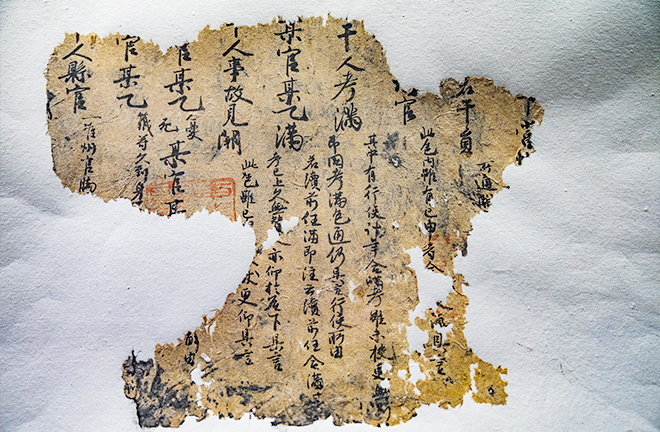Scholars dig historical value from Turpan documents

A scrap of a Tang Dynasty document unearthed in Turpan, Xinjiang Uygur Autonomous Region Photo: CFP
WUHAN—Scholars shed light on the historical value of documents unearthed in Turpan from philology, archaeology, regional social history, linguistics, and economics at the Seminar on the Review and Prospects of Turpan Studies in Wuhan, Hubei Province.
Documentary compilation
Located on the southern slope of the eastern Tianshan Mountains in Xinjiang Uygur Autonomous Region, the Turpan Basin is famous for its aridity, low rainfall, and high temperatures, a natural environment facilitating the preservation of documents. From 1959 to 1975, an archaeological team from the Xinjiang Uygur Autonomous Region Museum and the Institute for Preserving Turpan Cultural Relics conducted dozens of archaeological excavations in Turpan, unearthing nearly 400 tombs dating from between the Jin Dynasty (266–420) and the Tang Dynasty (618–907), along with a large collection of documents.
In late 1975, the National Cultural Heritage Administration set up a team for sorting out Turpan literature, headed by Wuhan University Professor Tang Changru. They worked to disassemble, link up, record, punctuate, date, and name thousands of scraps of paper, and compiled Documents Unearthed in Turpan, comprising a ten-volume edition and a four-volume hardcover edition. According to Meng Xianshi, a professor from the School of Chinese Classics at Renmin University of China, the team collected and compiled the Turpan documents from 13 archaeological excavations after the founding of the PRC in 1949, bringing forth new academic materials. The Turpan document studies initiative has since returned to the hands of Chinese academic circles.
Around 2008, during an inventory of its stockrooms, the Xinjiang Uygur Autonomous Region Museum found some documents that had been left out of Documents Unearthed in Turpan. After careful consideration, they invited Zhu Lei, a professor from the School of History at Wuhan University, who was experienced in compiling Turpan documents, to examine them. His book Supplement to Documents Unearthed in Turpan was published in April 2022.
Since the early 1980s, Rong Xinjiang, a professor from the Department of History at Peking University, has been working to collect Turpan documents scattered across various places, and compile them into Scattered Documents Unearthed in Turpan, published in 2021.
Diverse perspectives
In linguistics, the documents unearthed in Turpan form an important corpus of Chinese from middle-ancient and modern times. Wang Qitao, director of the Research Institute of Dunhuang and Turpan Literature at Southwest Minzu University, found in textual research that the value of Turpan literature in the history of linguistics and philology is at least embodied in phonetics, vocabulary, grammar, and writing. Its phonological systems tended to be simplified due to the influence of northern Altaic languages, while its vocabulary presented many new words, terms, and idioms. There were also new grammatical phenomena, such as a great many quantifiers, prefixes, and suffixes. In terms of writing, a large number of Chotscho [an ancient kingdom in Turpan] regional characters and usages came into being.
“Turpan documents provided first-hand materials for reviewing the daily life of the common people under the ruling of the Tang court in Shazhou and Xizhou [administrative regions at the time],” said Xu Chang, an associate professor from the School of History at Beijing Normal University. The fragmentary wooden slips and texts which contain household registrations, passes, letters of appointments, etc. unexpectedly offer traces of the activities of ordinary people from Chang’an [capital of Tang] and its vicinity. Out of exile, subsistence, trade, garrison, and Buddhist faith, they temporarily left their hometowns and traveled thousands of miles westward along the Silk Road, reaching as far as Xiyu [Western Regions]. Turpan documents offer a glimpse into the life of the people from Chang’an and its surrounding areas in northwestern China beyond settling down and farming, especially concerning leaving their familiar living environment and diving into social mobility. These records epitomize openness and high mobility in Tang.
Official papers
The team set up by the National Cultural Heritage Administration spent a dozen years recovering nearly 1,800 relatively complete official and private documents, uncovering the writings buried within millennial tombs and providing a host of valuable documents. Liu Anzhi, dean of the School of History at Wuhan University, noted that the Tang official documents unearthed in Turpan were primarily those of governments at various levels, with strict procedures for processing documents. Other official documents included letters of appointment, credentials, passes, and trading indentures, which were owned by individuals. The formats and procedures of official documents in Tang are not only of great academic significance for investigating administrative operations, institutional change, information transmission, and the relationship between central and local governments and between local governments, but also in terms of inspiring new ideas and methods for the rearrangement and research of documents.
Research on the Tang official documents based on Turpan literature has basically clarified the basic landscape and application scope of most documents used in daily scenes at the time, concluded Lei Wen, a professor from the School of History at Beijing Normal University. The vitality of the field lies in connecting itself with the changing national political systems, the relationship between central and local governments, state rule and primary-level governance upon studying the forms and processing links of specific documents.
Rong suggested the necessity of further researching Turpan literature, the regional social history of Turpan, ethnic relations as reflected in Chinese and minority language documents, and the interconnection of towns along the Silk Road.
Edited by YANG LANLAN
